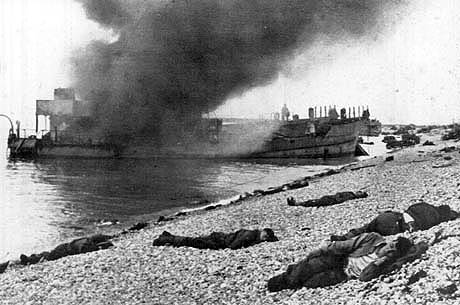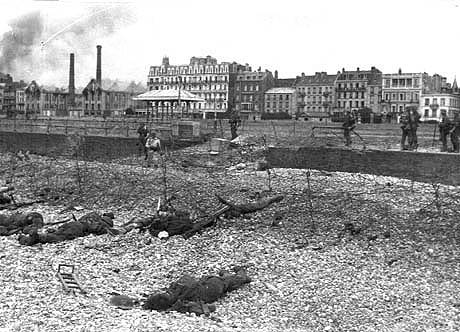|
Battle of DIEPPE

From the moment of the German attack against the Soviet Union on June 22nd 1941, and from that of the United States' entry into war the day after the Japanese attacked Pearl Harbour on 7th December 1941, the war became worldwide. In France, as in the whole of Europe, in order to face the war effort, Hitler's Germany imposed compulsory work service. While the "Todt Organisation" was building the Atlantic Wall, and was establishing Europe as a fortress, the "Third Reich" government intensified the implementation of Hitler's totalitarian and racial programme. Following the "Nacht und Nebel" decree in December 1941, which foresaw the putting into solitary confinement
and the deporting of the enemies of the New Order, the Wannsee conference finalized the ultimate solution to the Jewish problem. On 16th July, the "Vel d'Hiv" raid on Paris illustrated the repressive and antisemitic collaboration policy of the Vichy Government.
Operation Jubilee : aims and means
In April 1942, after the allied raid on St Nazaire,the British and American allies again took up the project of awide-ranging raid on a French harbour on the Channel coast. This raid was intended to test defences and to prove to the Soviets, who were asking for the establishment of a second front, that it was not easy to grab a foothold on the French coast. The Allied High Command chose Dieppe for two main reasons; the size of the township, and the
distance, which were both compatible with the available means of transport, making uninterrupted air-cover easy.
The operation was to last twelve hours, a front attack taking place on the beach at Dieppe, after landings on both sides at Pourville and Puys, thus neutralizing the defences overlooking the main beach. The long-range batteries at Varengeville and Berneval also had to be destroyed before the landing in Dieppe. The aim of the raid was to destroy the German coastal defences, the port structures and all the strategic buildings (petrol storage depots, radio and radar stations, headquarters, airfield?).
Over 6.000 men were to land, among them 4.965 Canadians from the 2nd Division (including the crews of 50 Churchill tanks) and 1.200 British men belonging to the Commandos and the Royal Marines. 250 boats effected the transport (duck-boats, destroyers, gunboats, patrol boats, landing-craft...). Around 1.000 aircraft (fighters, bombers) were used to support and defend the landing force.
In August 1942, the area of Dieppe was under the responsability of the 302nd Division of the Wehrmacht. About 2.500 men, highly trained and equiped (571st
Regiment of Grenadiers, artillery units, Flak units and Kriegsmarine units?), were present at each of the different landing-points. Important fresh troops could be sent for at short notice. The defensive fortifications were already dangerous, and the fire-power significant (automatic weapons, mortars, medium and heavy guns, long-range coast batteries?). The German airforce, although less extensive, was still very dangerous and had the advantage of being close to its home-base.
Attack and defeat
During the evening of 18th August, the naval forces of Operation Jubilee got under way from several ports on the south coast of England. The different groups accomplished a trouble-free sea-crossing until, suddenly, several miles off the coast, the left wing flotilla, which was carrying the 3rd British Commando unit, unexpectedly ran into a small German convoy sailing from Boulogne to Dieppe. It was 3.45am. The ensuing battle completely upset the planned attack on Berneval, and alerted part of the enemy defence. Yet, a small group of commandos still managed to neutralize the battery for an hour and a half.
At 4.50am, at the other end of the operation zone, the 4th Commando got a foothold on two areas along the coast, in order to catch the battery at Varengeville in a pincer movement. It was a complete success. The battery was destroyed and the commandos re-embarked at 8.15am with scarcely any human loss.
At Puys, the Royal Regiment of Canada landed at 5.06am, later than planned, and in broad daylight. The German defence was on the watch, overlooking the attackers who tried in vain to get over the high concrete wall enclosing the small beach, under heavy fire with no shelter. In less than an hour, of the 600 men who had landed, the Canadians had lost 225, those left were either wounded or made prisoner; only about sixty made it back to England.
The South Saskatchewan and Cameron Highlanders landed at Pourville at 4.50am, easily invading the village. The German defence became progressively firmer and although soldiers managed to advance as far as Petit Appeville in the valley and as far as two-thirds of the way up the slopes leading to Dieppe, they could not carry any further and had to fall back late in the morning, re-embarking with heavy losses (151 dead, 266 made prisoner and 269 wounded).
At 5.20am, after a too-short preliminary bombing, the first two assault waves of the Royal Hamilton and the Essex Scottish got a foothold on the beach at Dieppe. The tanks of the 14th Canadian Army Tank Regiment, which should have protected them, landed fifteen minutes
later with great difficulty and could not efficiently support the foot-soldiers advancing on the exposed esplanade, where a hell-fire showered them from the cliffs and the houses on the seafront. Even those who managed to reach the esplanade could not then get over the concrete walls barring every entrance to the town centre. The casino was occupied by some men from the Royal Hamilton. Several small groups even managed to get past the first rows of houses and to enter the church St Rémy.

On the east side of the beach, the men of the Essex Scottish, even more exposed, were very quickly stopped by intensive German gunfire (the troops having been defeated at Pourville and especially at Puys, the Germans had held on to their whole fire power). The Allied Command, based on the HMS Calpe, seeing nothing happening on land because of extremely thick smoke, and being badly informed because of failing transmissions, sent in fresh back-up troops, men from the Mount Royal Fusiliers and the Royal Marines Commandos. They landed on the beach amidst great confusion with no hope whatsoever of improving an already jeopardized situation. The murderous battle went on until the end of the morning, the order to draw back being given around 11am, to the survivors who tried to re-embark on the boats which had returned to pick them up. Of the 2.000 men who had landed, 400 were dead, and only 400 succeeded in regaining England. At about 1 pm, the battle was nearly over.
Evaluation and Controversy
Operation Jubilee ended with a dramatical result: the allies counted 1.380 dead
(913 Canadians), 1.600wounded and over 2.000 made prisoner. The air battle was just as disastrous. The Royal Air Force lost 107 aircraft; the Germans about forty. In the area of Dieppe, among the civilians, the count was 48 dead and 100 wounded. The Germans had 345 dead or missing and 268 wounded. Thus, in less than ten hours' battle, almost 1.800 people lost their lives, which shows clearly the murderous intensity of the Battle of Dieppe.
The result and ensuing debates could not live down the sacrifice of those who fought and the enemy was the first to admit that the disaster was not of their doing; « the huge number of prisoners may seem to question the value of the Canadian and British units involved in the raid. Far from it. The enemy soldiers, mostly Canadian, proved their skill and courage everywhere it was possible to fight? It was not their lack of courage, but the fact that we concentrated our defensive artillery fire and our heavy infantry weapons so much that stopped the enemy gaining ground? » (extracts of reports written by the majors of the 81st Corps and the 302nd German Division).
The sea-battle off Berneval breaking the surprise effect of the raid could not in itself explain the failure of Operation Jubilee. In fact, the reasons for this failure lie mainly in the underestimation of the enemy forces, the lack of effective air and sea support before landing, the use of inadequate equipment and the lack of information being other aggravating factors.
Military defeats are always controversial subjects, especially when loss of human life is involved. Operation Jubilee did not escape this rule and although the lessons learnt brought valuable indications for the preparation of Operation Overlord, the South Normandy landing on 6th June 1944, many wondered at the relevancy and usefulness of Operation Jubilee as far as future operations were concerned.
Two years after the raid on Dieppe, the Canadians landed in Juno, at dawn on 6th June 1944, participated in the Battle of Normandy and on 1st September 1944, the 2nd Canadian Division liberated Dieppe.
Alain Buriot
Arnaud Coignet
More on Dieppe
|